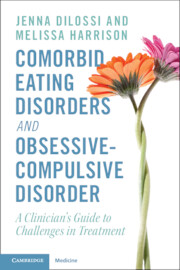 Comorbid Eating Disorders and Obsessive-Compulsive Disorder
Comorbid Eating Disorders and Obsessive-Compulsive Disorder from Part II - Clinical Pitfalls and Treatment Failures
Published online by Cambridge University Press: 14 December 2023
Some components of commonly used, empirically supported eating disorder treatments (CBT-E and FBT) may not be suitable for patients who also have OCD. These include aspects of parental control in FBT, collaborative weighing, self-monitoring and eating schedules/meal plans, and psychoeducation about food and weight. Achieving weight gain is particularly difficult in anorexia nervosa due to fear and preoccupation with weight, eating and “becoming fat.” Low body weight and malnourishment tends to increase anxiety and obsessionality, so weight gain early on is paramount, especially for individuals with this co-occurring presentation. Through clinical observations, patients have reported that FBT may aggravate OCD symptoms, such as preoccupation with numbers and exactness, and expanding obsessionality to concerns about exercise/movement and other topics within the morality domain of OCD. The lack of control and greater uncertainty that an adolescent experiences while completing FBT may be related to increased OCD symptomatology and poor treatment outcomes.
To save this book to your Kindle, first ensure [email protected] is added to your Approved Personal Document E-mail List under your Personal Document Settings on the Manage Your Content and Devices page of your Amazon account. Then enter the ‘name’ part of your Kindle email address below. Find out more about saving to your Kindle.
Note you can select to save to either the @free.kindle.com or @kindle.com variations. ‘@free.kindle.com’ emails are free but can only be saved to your device when it is connected to wi-fi. ‘@kindle.com’ emails can be delivered even when you are not connected to wi-fi, but note that service fees apply.
Find out more about the Kindle Personal Document Service.
To save content items to your account, please confirm that you agree to abide by our usage policies. If this is the first time you use this feature, you will be asked to authorise Cambridge Core to connect with your account. Find out more about saving content to Dropbox.
To save content items to your account, please confirm that you agree to abide by our usage policies. If this is the first time you use this feature, you will be asked to authorise Cambridge Core to connect with your account. Find out more about saving content to Google Drive.